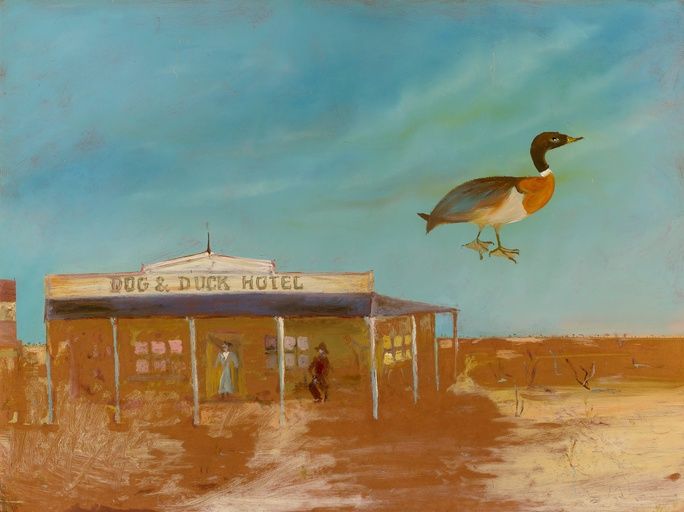

Dog and Duck Hotel , 1948
Sidney Nolan, Dog and Duck Hotel, 1948, Enamel paint on hardboard, 91.5 x 122 cm Collection: MONA (Museum of Old and New Art), Hobart, Tasmania, Australia
Jane Clark is the Senior Research Curator at Museum of Old and New Art Hobart, Tasmania, Australia
"I didn’t include Dog and Duck Hotel in Sidney Nolan’s 70th birthday retrospective exhibition. It was hanging in his sitting room at The Rodd and he didn’t seem keen when I broached the possibility of borrowing it for an eight-month Australian tour. It seemed so firmly and yet ironically ensconced: inversely emblematic of his transplantation from a working class, urban, colonial upbringing to that 17th-century manor farm in England’s green and pleasant land. A painting of a wide-verandahed building set mirage-like against sunbaked earth, with a name somehow redolent of an English duckhunter’s cosy pub. Hanging on a half-timbered wall above chintz-upholstered sofas and Lady Nolan serving tea.
Anyway, the Art Gallery of New South Wales had already agreed to lend their Pretty Polly Mine, painted the same year, the first acquisition of Nolan’s work by any public gallery; from the same 1949 series of far north Queensland outback paintings of which reviewer Harry Tatlock Miller had written, ‘I can remember no other exhibition by a contemporary Australian which, with such seemingly disarming innocence of eye and hand, reveals so much individuality of vision… Creatures of the air, he gaily tells us, flew gaudily, unreal, over desert, swamp, rock and river, … a land which existed at the dawn of history’.1 I’d first seen Dog and Duck on a Qantas airways in-flight menu brought home by my grandparents. Unforgettable. Even in reproduction, as Tatlock Miller put it so well, ‘These pictures remain in the mind persistently flavouring the following hours’.
Nolan had written to fellow artist Albert Tucker from North Queensland in 1947 about finding a surprisingly old-fashioned Englishness in the ‘lovely old hotels & shops that have been the same for seventy years’; so far distant even from Melbourne, let alone England. And yet, joining a Royal Geographical Society expedition to the Cape York Peninsula and out west to the Carnarvon Range, he described ‘feeling perhaps that a large part of the energy of Australia is contained there’.2 Apparently he did meet a mine manager who fed the local parrots. Who knows if he really found a hotel called ‘Dog and Duck’. No duck ever flew like this one, dangling in the sky. And the small eponymous dog is scarcely there.
We do know that the painting was made from memory. Nolan’s habit was to imprint visually almost without seeming to look, storing images indelibly in his imagination for the future; sometimes taking photographs; often writing short encapsulations in notebooks as an aide-mémoire. Back in Sydney, he worked through much of 1948 painting shopfronts, farm machinery, abandoned and working mines, prospectors, explorers, anthills, and seemingly empty desertscapes, as well as birds and old hotels. He painted quickly, here using glossy Ripolin enamel for the clear blue sky (Picasso had called it ‘healthy paint’) and leaving the reddish brown hardboard bare for much of the lower part of the composition: ‘a minimum of matter to give the maximum effect in the manner of a lyric poet’, as the Sydney Morning Herald’s art critic wrote of his technique.3
The 1949 exhibition sold well. Sir Kenneth Clark bought Little Dog Mine: as Slade Professor of Fine Arts at Oxford and former director of the London National Gallery, he was very influential and arguably launched Nolan’s international career. Dog and Duck Hotel went to the Sydney collector Mervyn Horton, later founding editor of Art and Australia. It passed next, in 1972, for the then Australian-record price of $60,000 to Alistair McAlpine who later sold it back to Sidney.
Having seen the painting ‘for real’ at The Rodd, I was rather sad, though greatly honoured, to oversee its sale in 2001 as part of The Estate of Sir Sidney Nolan when I was Deputy Chairman at Sotheby’s in Melbourne: the highest-priced lot in the auction. But we met again, picture and I. When I came to work for Mona, in Tasmania — in 2007, before the museum was built — Dog and Duck Hotel had changed hands again and was owned my new boss, David Walsh. It amuses, intrigues, impresses, and inspires me every time I look."